Serevent 50 Microgram Diskhaler
Out of date information, search another5, HOW TO STORE SEREVENT DISKHALER
6, FURTHER INFORMATION
What Serevent Diskhaler looks like and contents of the pack
The diskhaler has a two tone green diskhaler device and 15 disks with four regularly spaced double foil blisters.
Available in packs of one diskhaler & 14 disks x 4 blisters or 15 disks x 4 blisters.
Manufacturer and Licence Holder
This Diskhaler and Disks are manufactured by Glaxo Wellcome GmbH & Co., Industriestrasse 32-36, D-23843, Bad Oldsloe, Germany and are procured from within the EU and repackaged by the Product Licence Holder: Lexon (UK) Limited, Unit 18, Oxleasow Road, East Moons Moat, Redditch, Worcestershire, B98 0RE.
If you have any questions or are not sure about anything, ask your doctor or pharmacist. They will have additional information about this medicine and will be able to advise you.
POM
PL 15184/0369 - Serevent Diskhaler
Serevent and Diskhaler are registered trademarks of Glaxo Group Limited.
Leaflet revision date: 22/03/13
Blind or partially sighted?
Is this leaflet hard to see or read? Phone Lexon (UK) Limited,
Tel: 01527 505414 for help.
1, WHAT SEREVENT DISKHALER IS AND WHAT IT IS USED FOR
2, BEFORE YOU USE SEREVENT DISKHALER
PATIENT INFORMATION LEAFLET Ref 0369220313 1 F
SEREVENT®DISKHALER®
(salmeterol xinafoate)
Other side effects are listed below:
Common (affects less than 1 person in 10):
• Muscle cramps
• Feeling shaky; fast or uneven heartbeat (palpitations), headache, shaking hands (tremor). Tremors are more likely if you are taking more than one blister twice daily. These side effects do not last long and happen less as treatment with Serevent continues.
Uncommon (affects less than 1 person in 100):
• Rash
• Very fast heart rate (tachycardia). This is more likely to happen if you are taking more than one blister twice daily
• Feeling nervous.
Rare (affects less than 1 person in 1,000):
• Feeling dizzy
• Being unable to sleep or finding sleep difficult
• A reduction in the amount of potassium in your blood (you may get an uneven heartbeat, muscle weakness, cramp).
The following side effects have been reported when using Serevent, but it is not known how often they occur:
• Breathing difficulties or wheezing that gets worse straight after taking Serevent. If this happens stop using your Serevent Diskhaler.
Use your fast-acting ‘reliever' inhaler to help your breathing and tell your doctor straight away
• Uneven heartbeat or your heart gives an extra beat (arrhythmias). If this happens do not stop using Serevent but tell your doctor
• Sore mouth or throat
• High blood sugar
• Feeling sick (nausea)
• Aching, swollen joints or chest pain.
If any of the side effects gets serious, or if you notice any side effects not listed in this leaflet, please tell your doctor, nurse or pharmacist.
• Keep out of the sight and reach of children.
• Do not store above 25°C.
• Do not puncture the blisters until you are ready to inhale a dose.
If your medicine becomes discoloured or shows any other signs of deterioration, consult your pharmacist who will tell you what to do.
Medicines should not be disposed of via wastewater or household waste. Ask your pharmacist how to dispose of medicines no longer required. These measures will help to protect the environment.
Do not use this medicine after the expiry date shown on the Serevent label or carton label.
What Serevent Diskhaler contains
Each disk contains powder for inhalation providing 50 micrograms of salmeterol (as xinafoate). Inactive ingredients: Lactose.
Available in packs of one diskhaler & 14 disks x 4 blisters or 15 disks x 4 blisters.
Read all of this leaflet carefully before you
start taking this medicine.
• Keep this leaflet. You may need to read it again.
• If you have any further questions, ask your doctor or pharmacist.
• This medicine has been prescribed for you. Do not pass it on to others. It may harm them, even if their symptoms are the same as yours.
• If any of the side effects gets serious, or if you notice any side effects not listed in this leaflet, please tell your doctor or pharmacist.
In this leaflet:
1, What Serevent Diskhaler is and what it is used for
2, Before you use Serevent Diskhaler
3, How to use Serevent Diskhaler
4, Possible side effects
5, How to store Serevent Diskhaler
6, Further information
• Serevent Diskhaler consists of Rotadisks and an inhaler called a Diskhaler. Rotadisks have foil blisters containing the medicine salmeterol. Refill packs are also available which contain only the Rotadisks and not the Diskhaler.
• Serevent contains the medicine salmeterol. It is a ‘long-acting bronchodilator'. It helps the airways in the lungs to stay open. This makes it easier for air to get in and out. The effects are usually felt within 10 to 20 minutes and last for 12 hours or more.
• The doctor has prescribed it to help prevent breathing problems. These could be caused by asthma.
• Taking Serevent Diskhaler regularly will help prevent asthma attacks.
• This also includes asthma brought on by exercise or at night.
• Taking Serevent Diskhaler regularly will also help prevent breathing problems caused by other chest illnesses such as Chronic Obstructive Pulmonary Disease (COPD).
• Serevent Diskhaler helps to stop breathlessness and wheezing coming on. It does not work once you are breathless or wheezy. If that happens you need to use a fast acting ‘reliever' medicine, such as salbutamol.
• Serevent is supplied to you in a Diskhaler. You breathe the medicine directly into your lungs.
If you are being treated for asthma, you should
always be given both a Serevent and a steroid
inhaler to use together.
Do not take Serevent Diskhaler if:
you are allergic (hypersensitive) to salmeterol xinafoate, or to the other ingredient lactose monohydrate.
Take special care with Serevent Diskhaler
• If you are using Serevent for asthma your doctor will want to regularly check your symptoms.
• If your asthma or breathing gets worse tell your doctor straight away. You may find that you feel more wheezy, your chest feels tight more often or you may need to use more of your fast acting ‘reliever' medicine. If any of these happen, do not increase your number of blisters of Serevent. Your chest condition may be getting worse and you could become seriously ill. See your doctor as you may need a change in asthma treatment.
• Once your asthma is well controlled your doctor may consider it appropriate to gradually reduce the dose of Serevent.
• If you have been prescribed Serevent for your asthma, continue to use any other asthma medication you are already taking. These could include a steroid inhaler or steroid tablets. Continue taking the same doses as before, unless your doctor tells you otherwise. Do this even if you feel much better. Do not stop taking your steroid inhaler (or any steroid tablets) when you start using Serevent.
• Your doctor may want to check your health regularly if you have an overactive thyroid gland, diabetes mellitus (Serevent may increase your blood sugar) or heart disease, including an irregular or fast heartbeat.
Taking other medicines
• Please tell your doctor if you are taking or have recently taken any other medicines. This includes those for asthma or any other medicines obtained without a prescription. This is because Serevent may not be suitable to be taken with other medicines.
• Please inform your doctor before using Serevent if you are currently being treated for any fungal infections with medicines containing ketoconazole or itraconazole, or if you are being treated for HIV with ritonavir. These medicines may increase the risk of you experiencing side effects with Serevent, including irregular heart beats, or may make side effects worse.
• Beta-blockers should be avoided when taking Serevent, unless your doctor tells you to take them. Beta-blockers, including atenolol, propranolol and sotalol, are mostly used for high blood pressure or other heart conditions. Please tell your doctor if you are taking beta-blockers or have recently been prescribed beta-blockers as they may reduce or abolish the effects of salmeterol.
• Serevent can reduce the amount of potassium in your blood. If this happens you may notice an uneven heartbeat, muscle weakness or cramp. This is more likely to happen if you take Serevent with some medicines used to treat high blood presssure (diuretics - water tablets) and other medicines used to treat breathing problems such as theophylline or steroids. Your doctor may ask for you to have blood tests to check the amount of potassium in your blood. If you have any concerns discuss them with your doctor.
Pregnancy and breast-feeding
If you are pregnant, planning to get pregnant or
breast-feeding, talk to your doctor before taking
Serevent. Your doctor will assess whether you can
take Serevent during this time.
Driving and using machines
The possible side effects associated with Serevent are unlikely to affect your ability to drive or use machines.
3, HOW TO USE SEREVENT DISKHALER
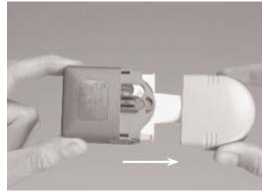
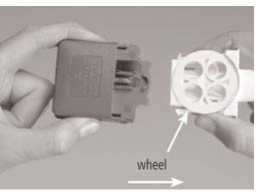
• If you are being treated for asthma, you should always be given both a Serevent and a steroid inhaler to use together.
• Use Serevent every day, until your doctor advises you to stop. Serevent is for inhalation by mouth only.
Using this medicine
The medicine in Serevent Diskhaler should be inhaled using a special kind of inhaler called a Diskhaler.
• Make sure that you have one and can use it properly.
• Instructions on how to use the Diskhaler are given as a step-by-step guide below.
• If you are not sure how to use the Diskhaler, ask your nurse, pharmacist or doctor to go through the instructions with you.
• You will start to feel your medicine working within the first day of use and it is very important that you use it regularly.
Adults and adolescents aged 12 years and older with Asthma
• The usual starting dose is 1 blister twice a day.
• For people with more severe asthma, your doctor may increase your dose to 2 blisters twice a day.
Children with Asthma
• In children aged 4 to 12 the usual dose is 1 blister twice a day.
• Serevent is not recommended for use in children below 4 years of age.
Adults with Chronic Obstructive Pulmonary Disease (COPD) including bronchitis and emphysema
• The usual starting dose is 1 blister twice a day.
• Not applicable for children and adolescents.
Using your Diskhaler
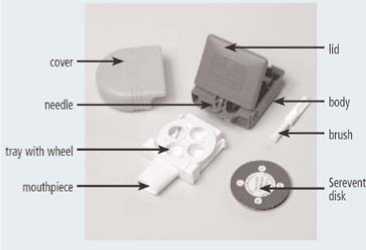
The Diskhaler has a number of parts:
• a green outer body with a hinged lid and piercing needle
• a cleaning brush which fits into a space at the rear of the body
• a mouthpiece cover
• a white wheel on which the disk is placed. The wheel is fitted to -
• a white sliding tray with mouthpiece
Loading a disk into the Diskhaler
1, Take off the mouthpiece cover and check inside and outside to make sure that the mouthpiece is clean, and that there are no foreign objects.
2, Hold the corners of the white tray and pull out gently until you can see all the plastic ridges on the sides of the tray.
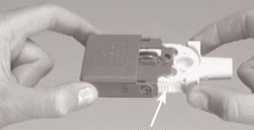
plastic
ridges
3, Put your finger and thumb on the ridges, squeeze inwards and gently pull the tray out of the body of the Diskhaler.
4, Place a disk on the wheel so that the numbers face upwards and then slide the tray back into the Diskhaler.
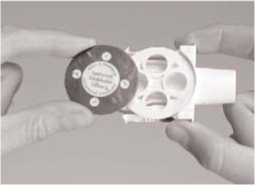
Getting ready for the first dose
5, Hold the corners of the tray as shown in the picture and slide the tray out and in. This will rotate the disk.
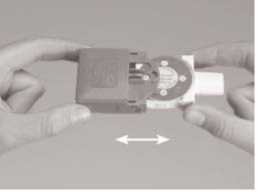
6, Continue until the number ‘4' appears in the small window. The disk is now ready for use. As you use each dose the number of doses remaining is shown in the window.
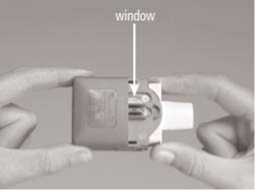
Opening the blister to release a dose
7, Keep the Diskhaler level. Lift up the back of the lid as far as it will go and until it is fully upright. The lid must be raised until fully upright to pierce both the top and bottom of the blister. This will need firm pressure.
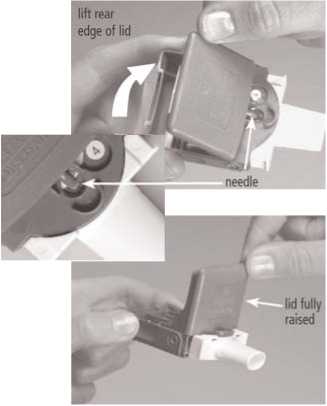
Then close the lid.
The Diskhaler is now ready for use.
Do not try to lift the lid until the white sliding tray is pushed fully in or is completely removed e.g. when cleaning the Diskhaler.
Inhaling your medicine
8, Breathe out as far as is comfortable.
9, Keep the Diskhaler level and raise it to your mouth. Place the mouthpiece between your teeth and close your lips firmly around it but do not bite it. Do not cover the small air holes on either side of the mouthpiece.
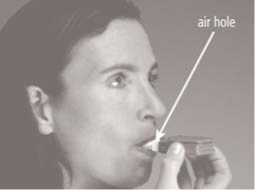
10, Suck in through your mouth as quickly and as deeply as you can.
11, Hold your breath and remove the Diskhaler from your mouth. Continue to hold your breath for a few seconds or as long as is comfortable.
Getting ready for the next dose
12, Turn the disk to the next number "3” by gently pulling out the tray and pushing it in once.
Do not open the blister until you are ready to take the next dose.
When you need to take another dose repeat steps 7 to 12.
Always wipe the mouthpiece with a tissue and replace the cover after use.
Replacing the disk when it is empty
13, Each disk has four blisters. As you use up each blister, numbers will count backwards i.e. ‘4', ‘3', ‘2', ‘1'. When the number ‘4' reappears, the disk is empty and should be replaced. To take out the old disk and put in the new one, repeat steps 2 to 4.
Cleaning your diskhaler
14, There is a brush in the small space under the lid at the rear of the Diskhaler body.
a) Remove the tray from the Diskhaler body.
b) Brush away any powder left behind on the parts of the Diskhaler.
c) Replace the tray and mouthpiece cover.
You may need to replace your Diskhaler after about three months of use.
Serevent disks should only be used in a Serevent Diskhaler.
If you use more Serevent than you should
It is important to use the inhaler as instructed. If you accidentally take a larger dose than recommended, talk to your doctor or pharmacist. You may notice your heart beating faster than usual and that you feel shaky and/or dizzy. You may also have a headache, muscle weakness and aching joints.
If you forget to use Serevent
If you forget to use your Serevent Diskhaler, take your next dose when it is due. Do not take a double dose to replace the one you forgot.
If you stop using Serevent Diskhaler Do not stop treatment even if you feel better unless told to do so by your doctor. If you have any further questions on the use of this product, ask your doctor or pharmacist.
4, POSSIBLE SIDE EFFECTS
Like all medicines, Serevent can cause side effects, although not everybody gets them. To reduce the chances of side effects, your doctor will prescribe the lowest dose of Serevent to control your asthma or COPD. These are the side effects reported by people taking Serevent.
Allergic reactions: you may notice your breathing suddenly gets worse after using Serevent. You may be very wheezy and cough. You may also notice itching and swelling (usually of the face, lips, tongue or throat). If you get these effects or they happen suddenly after using Serevent, tell your doctor straight away. Allergic reactions to Serevent are very rare (they affect less than 1 person in 10,000).
Ref: 0369/220313/1/B